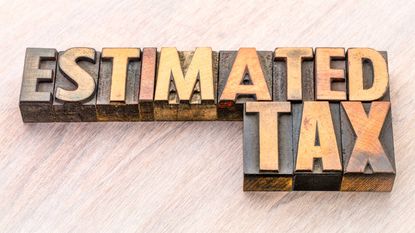11 Reasons to File a Tax Return Even If You Don't Have To
Although you might not be required to file a tax return, it might be wise to file one anyway. Here are a few reasons why.


Filling out tax forms is a pain in the you-know-what. So why on earth would anyone file a tax return if they don't have to? Well, actually, there's one very important reason why – you might get a big, fat tax refund check in the mail.
People with income under a certain amount (see table below) aren't required to file a tax return because they won't owe any tax. But if you qualify for certain tax credits or already paid some federal income tax, Uncle Sam might owe you a refund that you can only get by filing a return. Think about that for a minute!
If you want to know more, here are 11 reasons why you might want to file a tax return even if you don't have to. Although dealing with taxes can be a real drag, it's probably worth it if you wind up with a much fatter wallet in the end. (Note that the IRS won't penalize you for filing a late return if you're getting a refund.)
Who Has to File a Tax Return?
Here are the federal tax return filing requirements for the 2021 tax year:
| Filing Status and Age at End of 2021 | Filing Required If Income is At Least |
|---|---|
| Single; Under 65 | $12,550 |
| Single; 65 or Older | $14,250 |
| Married Filing Jointly; Both Spouses Under 65 | $25,100 |
| Married Filing Jointly; One Spouse 65 or Older | $26,450 |
| Married Filing Jointly; Both Spouses 65 or Older | $27,800 |
| Married Filing Separately; Any Age | $5 |
| Head of Household; Under 65 | $18,800 |
| Head of Household; 65 or Older | $20,500 |
| Qualifying Widow(er); Under 65 | $25,100 |
| Qualifying Widow(er); 65 or Older | $26,450 |

Withheld Taxes
If an employer withheld federal income taxes from your paycheck last year, or taxes were withheld from other sources of income in 2021, you might be entitled to a refund if you file a 2021 tax return. If you don't owe any tax – and, therefore, aren't required to file a return – then it only makes sense that any taxes you already paid should be refunded to you. But you won't get that money back if you don't file a 1040 form.
You may also be entitled to a refund if too much Social Security or Tier 1 Railroad Retirement taxes were withheld from your 2021 paychecks. This could happen if you had multiple employers for 2021 and total wages of more than $142,800. If that's the case, you can claim a refundable tax credit on your 2021 return for the amount withheld in excess of $8,853.60. (If a "refundable" credit is worth more than the income tax you owe, the IRS will issue you a refund check for the difference. With a "nonrefundable" credit, you don't get a refund because the tax you owe isn't reduced below zero.)
If you had only one employer last year that withheld more than $8,853.60, you can't claim the credit. Instead, the employer should adjust the tax for you. If you can't get the employer to make an adjustment, you can claim a refund using Form 843.

Taxes Paid
Withholding isn't the only way you could have already paid taxes for 2021 to Uncle Sam. For instance, if you received income as an independent contractor or were otherwise self-employed, you may have made estimated tax payments last year. If you filed a 2020 tax return, you may have applied your refund from that return to your 2021 taxes (it's optional). If you're filing an extended return, you should have paid the amount of tax you expect to owe when you requested the extension with Form 4868.
If you paid 2021 taxes in advance in one of these three ways, make sure you file a tax return even if your overall income is below the applicable filing threshold amount. That will allow you to get that money back.

Earned Income Tax Credit
The Earned Income Tax Credit (EITC) is for lower income working people. If you qualify for this refundable credit, then you definitely want to file a tax return. For the 2021 tax year only, more workers without children qualify for the EITC. Plus, if your child doesn't have a Social Security number, you can now claim the EITC that's available to childless workers for 2021 and beyond. So, even if you weren't eligible for the credit in previous years, make sure you check it out this year because you may qualify now.
For 2021 tax returns, the maximum EITC ranges from $1,502 to $6,728 depending on your income and how many children you have. So, it's well worth the time it takes to complete a tax form if you qualify for the credit.
The income limits to qualify for the EITC are fairly low. For example, if you don't have kids, you can qualify if your 2021 earned income and adjusted gross income (AGI) are each less than $21,430 for singles and $27,380 for joint filers. If you have three or more children and are married, though, your 2021 earned income and AGI can be as high as $57,414. Plus, you can use your earned income from 2019 to determine the EITC for the 2021 tax year if it results in a higher credit amount. There are many exceptions and other rules, but the IRS has a handy online tool to help you figure out if you're eligible for the credit.

Child Tax Credit
There are a lot of temporary enhancements to the child tax credit for the 2021 tax year (and only for the 2021 tax year). The credit amounts are higher, more children qualify, and it's fully refundable on your 2021 tax return. Generally, parents with children 17 years old or younger may qualify for the 2021 child tax credit. The maximum credit amount is $3,000 for each child age 6 to 17, and $3,600 for each child 5 years old and younger. So, like the EITC, you could end up with a nice refund check by filing a return just to claim this credit.
However, if you received any monthly child tax credit payments from July to December last year, you must subtract the total amount of those payments from the credit amount you're entitled to claim on your 2021 return. That's because those monthly payments were simply advance payments of the 2021 credit. (Use our 2021 Child Tax Credit Calculator to see how much you should have received in monthly payments last year and how much you should have left to claim on your 2021 tax return.) For all the details about the 2021 credit, see Child Tax Credit FAQs for Your 2021 Tax Return.
Not sure if you qualify for the credit? The IRS has an online tool to help with that. But note that you might be able to claim a different tax credit for your dependents if you don't qualify for the child tax credit. There's something called the "credit for other dependents," and it's worth up to $500 for each qualifying dependent. It's a nonrefundable credit, though. So, it won't trigger a refund if you otherwise don't owe any tax.

Child and Dependent Care Credit
As with the child tax credit, there were several enhancements made to the child and dependent care tax credit that only apply for the 2021 tax year – including making the credit refundable for people who live in the U.S. for more than half of the year, which means you definitely want to file a 2021 tax return if you qualify for the credit.
The credit helps people who work, are looking for work, or attending school pay for the care of children under 13 or certain other people who can't care for themselves. In addition to being refundable, credit amounts will be higher and more people will qualify for the credit on their 2021 tax returns.
For the 2021 tax year, you're eligible for a 20% to 50% credit for up to $8,000 in care expenses for one child or other qualifying person or up to $16,000 in expenses for two or more. There are income limits, though. You're eligible for the full credit if your AGI doesn't exceed $125,000. The percentage is gradually reduced from 50% to 20% if your AGI is between $125,001 and $183,000. It stays at 20% if your AGI is from $183,001 to $400,000, but then it's gradually reduced again from 20% to 0% if your AGI is between $400,001 and $438,000. You can't claim the credit if you make over $438,000.
For more information on the 2021 credit, see Your Child Care Tax Credit May Be Bigger on Your 2021 Tax Return.

Recovery Rebate Credit
If you didn't get a third stimulus check, or you didn't get the full amount, you may be able to get paid now by claiming the recovery rebate credit on your 2021 tax return. The third-round stimulus checks (including "plus-up" payments) were actually just advance payments of the credit. So, if you didn't get the money earlier, you should get it now (assuming you're eligible).
You're generally eligible to claim the recovery rebate credit on your 2021 return if, in 2021, you:
- Were a U.S. citizen or U.S. resident alien;
- Can't be claimed as a dependent on another person's tax return; and
- Have a Social Security number valid for employment that's issued before the due date of your 2021 tax return (including extensions).
Calculation of the recovery rebate credit is generally the same as the calculation for the third round of stimulus checks, except that the credit is based on information from different sources. The third-round stimulus checks were typically based on information from either your 2019 or 2020 tax return, whichever was most recently filed when the IRS began processing your payment (use Kiplinger's Third Stimulus Check Calculator to see how much you should have gotten). However, the amount of your recovery rebate credit is based on information found on your 2021 tax return. For more information, see What's the Recovery Rebate Credit?

American Opportunity Tax Credit
The American Opportunity credit covers expenses for students who are in their first four years of college. The credit is worth up to $2,500 per eligible student, and it can be claimed by a parent, spouse or student who is not claimed as a dependent for tuition, fees, or textbooks.
The credit is partially refundable. So, if the credit is worth more than your tax liability for the year, you'll get a refund check for 40% of the remaining amount – up $1,000 for each qualifying student. That should be enough to get you to complete a tax return if you don't otherwise have to file one.
As with the EITC and child tax credit, the IRS has an online tool to help you figure out if you're eligible for the American Opportunity credit. It will also help you determine if you can claim the non-refundable Lifetime Learning credit, which is available for an unlimited number of years.

Premium Tax Credit
The premium tax credit helps people pay for insurance they buy through the health insurance marketplace (i.e., Obamacare). Normally, the credit is available for people with household incomes ranging from 100% to 400% of the federal poverty level. However, for the 2021 and 2022 tax years, people with a household income that exceeds 400% of the federal poverty line for their family size may still claim the credit. The amount of the premium tax credit is based on a sliding scale, so that people with a lower income get a larger credit.
An estimated credit is calculated when you go on a marketplace website such as healthcare.gov to buy insurance. At that point, you can choose to have the credit paid in advance directly to the insurance company to lower your monthly payments, or you can choose to get all the benefit of the credit when you file your tax return for the year. If you elect to have advance premium tax credit (APTC) payments made to the insurer, you must file a tax return and reconcile the amount paid in advance with the actual credit you compute when you file your return. Either way, you'll need to complete Form 8962 and attach it to your tax return.
The premium tax credit is another refundable credit. So, if the amount of the credit is more than the amount of the tax you owe, you'll receive the difference as a refund if you file a tax return. If you owe no tax, you can get the full amount of the credit as a refund. However, if your actual allowable credit is less than your APTC payments, the difference is usually subtracted from your refund or added to the tax you owe.
Be warned, though, that the IRS typically looks for people who receive advance credits and either don't file returns or file returns incorrectly reporting the credit. So, monkeying around with the premium tax credit is a good way to get your return audited.

Health Coverage Tax Credit
The health coverage tax credit helps certain displaced workers and pre-retirees pay for health insurance. Specifically, it is available to (1) people eligible for Trade Adjustment Assistance allowances because of a qualifying job loss, and (2) people between 55 and 64 years old whose pension plans were taken over by the Pension Benefit Guaranty Corporation. The credit is worth up to 72.5% of payments for qualified health insurance coverage.
As with the other credits we've mentioned, the health coverage credit is refundable. So, if you can claim the credit, you'll want to file a tax return just to claim the credit, even if you're not required to file a return. By doing so, you can get a federal income tax refund check sent to you.
As with the premiums tax credit, the health coverage credit can be paid in advance. If you received advance payments last year, you must file a 2021 tax return. That also means that your refund will be smaller (or eliminated) if the advance credit payments are greater than your actual allowable credit.
Also note that the health coverage credit expired at the end of 2021, so you won't be able to claim it next year when you file your 2022 tax return.

Credits for Sick and Family Leave
Many employers provided paid sick and family leave in 2021 for workers affected by COVID-19. However, to shift most of the financial burden for paid leave off the employer's back, tax credits were also made available to reimburse employers for some of the cost of leave taken through September 30, 2021. Self-employed people who couldn't work because of certain COVID-related circumstances got similar refundable tax credits, too.
The credits are generally equivalent to the amount of qualified sick or family leave wages the self-employed person would have received if he or she were an employee. To be eligible for the 2021 self-employment credits, you must have regularly carried on a trade or business during the year and been eligible to receive sick or family leave wages if you had been an employee of an employer (other than yourself). The sick and family leave credits are different depending on whether the leave was taken before or after April 1, 2021. Complete Form 7202 to calculate the credit amounts.
People who paid household employment taxes might also be able to claim refundable credits for a portion of any sick or family leave wages they paid that were related to COVID-19. The 2021 credit amounts are shown on Schedule H, Lines 8e and 8f.
As with the other refundable credits discussed, the credits for sick and family leave can lower your tax bill or even result in a tax refund. So, make sure you claim them even if you aren't required to file a 2021 tax return.

Credit for Federal Fuel Taxes
The federal government taxes most fuel purchases (e.g., 18.4¢ per gallon tax on gasoline). But some people can claim a credit on their tax return if they burn the fuel during certain non-taxable activities. This credit is typically claimed by businesses, but some individuals can claim it too if they qualify. For example, farmers and fishermen can claim the credit if they're the ultimate purchaser of gasoline used on a farm for farming purposes or in a boat engaged in commercial fishing.
The credit is refundable, so you'll certainly want to file a tax return if you qualify for the credit. You must fill out Form 4136 to calculate the credit amount, and then attached the form to your return.
Get Kiplinger Today newsletter — free
Profit and prosper with the best of Kiplinger's advice on investing, taxes, retirement, personal finance and much more. Delivered daily. Enter your email in the box and click Sign Me Up.
Rocky Mengle was a Senior Tax Editor for Kiplinger from October 2018 to January 2023 with more than 20 years of experience covering federal and state tax developments. Before coming to Kiplinger, Rocky worked for Wolters Kluwer Tax & Accounting, and Kleinrock Publishing, where he provided breaking news and guidance for CPAs, tax attorneys, and other tax professionals. He has also been quoted as an expert by USA Today, Forbes, U.S. News & World Report, Reuters, Accounting Today, and other media outlets. Rocky holds a law degree from the University of Connecticut and a B.A. in History from Salisbury University.
-
 Want to Retire With $100K a Year? Here's How Much to Save
Want to Retire With $100K a Year? Here's How Much to SaveWhat "magic number" will be enough to generate $100K a year in retirement income? We do the math for you.
By Adam Shell Published
-
 Rethinking Income When You Retire: No Paycheck, No Problem
Rethinking Income When You Retire: No Paycheck, No ProblemWhen you retire, you'll need to adjust to the reality of depending on assets instead of a regular paycheck. For that, you'll need a new financial strategy.
By Joel V. Russo, LUTCF Published
-
 Ten IRS Audit Red Flags for Retirees in 2025
Ten IRS Audit Red Flags for Retirees in 2025Retirement Taxes Retirees who think they can escape the IRS audit machine should think again.
By Joy Taylor Published
-
 New Colorado Tax Credit: What’s the Scoop?
New Colorado Tax Credit: What’s the Scoop?State Tax Everything you need to know about the Colorado family affordability tax credit in 2025.
By Kate Schubel Published
-
 Could ERC Delays Get Worse if Trump Downsizes the IRS?
Could ERC Delays Get Worse if Trump Downsizes the IRS?IRS The Trump administration’s push to shave down the IRS can impact taxpayers like you.
By Gabriella Cruz-Martínez Published
-
 IRS Income Tax Refund Schedule 2025: When Will Your Refund Arrive?
IRS Income Tax Refund Schedule 2025: When Will Your Refund Arrive?Tax Refunds Your 2025 IRS tax refund may arrive sooner than you think. Here’s a schedule for when you can expect your check or direct deposit.
By Kate Schubel Published
-
 IRS Tax Refunds Are $526 Bigger This Year: Here's Why
IRS Tax Refunds Are $526 Bigger This Year: Here's WhyTax Refunds Inflation-related changes to the tax code could result in a larger refund.
By Gabriella Cruz-Martínez Published
-
 Ten IRS Audit Red Flags for Self-Employed Individuals
Ten IRS Audit Red Flags for Self-Employed IndividualsIRS Audits Taxpayers who file Schedule C with their Form 1040 have a greater chance of an IRS audit.
By Joy Taylor Published
-
 Trump Wants You Out of the IRS, But You'll Have to Wait Until May
Trump Wants You Out of the IRS, But You'll Have to Wait Until MayIRS Some IRS employees won’t be able to resign using the buyout offer until the end of tax season.
By Gabriella Cruz-Martínez Published
-
 Key Family Tax Breaks Are on the GOP Chopping Block This Year
Key Family Tax Breaks Are on the GOP Chopping Block This YearTax Credits Several tax breaks, including the Child Tax Credit, may face reforms or be cut entirely as lawmakers seek revenue for Trump’s tax plans.
By Gabriella Cruz-Martínez Last updated
